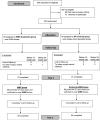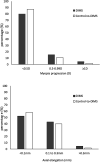Myopia control effect of defocus incorporated multiple segments (DIMS) spectacle lens in Chinese children: results of a 3-year follow-up study
- PMID: 33731364
- PMCID: PMC9340033
- DOI: 10.1136/bjophthalmol-2020-317664
Myopia control effect of defocus incorporated multiple segments (DIMS) spectacle lens in Chinese children: results of a 3-year follow-up study
Abstract
Aims: To determine myopia progression in children who continued to wear the defocus incorporated multiple segments (DIMS) lenses or switched from single vision (SV) to DIMS lenses for a 1-year period following a 2-year myopia control trial.
Methods: 128 children participated in this study. The children who had worn DIMS lenses continued to wear DIMS lenses (DIMS group), and children who had worn SV lenses switched to wear DIMS lenses (Control-to-DIMS group). Cycloplegic spherical equivalent refraction (SER) and axial length (AL) were measured at 6-month interval. Historical controls were age matched to the DIMS group at 24 months and used for comparing the third-year changes.
Results: Over 3 years, SER and AL changes in the DIMS group (n=65) were -0.52±0.69D and 0.31±0.26 mm; these changes were not statistically significant over time (repeated measures analysis of variance, p>0.05).SER (-0.04±0. 38D) and AL (0.08±0.12 mm) changes in the Control-to-DIMS group (n=55) in the third year were less compared with the first (mean difference=0.45 ± 0.30D, 0.21±0.11 mm, p<0.001) and second (0.34±0.30D, 0.12±0.10 mm, p<0.001) years.Changes in SER and AL in both groups over that period were significantly less than in the historical control group (DIMS vs historical control: mean difference=-0.18±0.42D, p=0.012; 0.08±0.15 mm, p=0.001; Control-to-DIMS versus historical control: adjusted mean differences=-0.30±0.42D, p<0.001; 0.12±0.16 mm, p<0.001).
Conclusions: Myopia control effect was sustained in the third year in children who had used the DIMS spectacles in the previous 2 years and was also shown in the children switching from SV to DIMS lenses.
Keywords: child health (paediatrics); clinical trial.
© Author(s) (or their employer(s)) 2022. Re-use permitted under CC BY-NC. No commercial re-use. See rights and permissions. Published by BMJ.
Conflict of interest statement
Competing interests: This collaborative research was supported by HOYA Corporation, Tokyo, Japan. Patents titled ‘Spectacle Lens’ in China (CN104678572 B) and USA (US10268050 B2) were issued on 27 April 2018 and 23 April 2019 respectively.
Figures



References
Publication types
MeSH terms
LinkOut - more resources
Full Text Sources
Other Literature Sources
Medical
